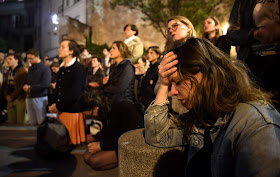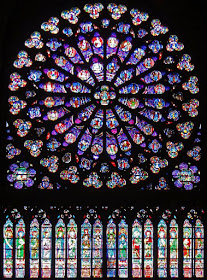About an hour after I started watching the images coming in, the spire made of timbers and lead over the crossing went up in flames like a match and collapsed in a fiery crash. Like so many, I thought the 850 year old cathedral was lost along with all the treasures housed inside.
Grief stricken Parisians watched the cathedral burn in stunned silence.
A lot of people including me shared their shock and grief around the world, and thanks to the technology of instant communication, we could share it in real time.
Everlasting gratitude to the Paris fire department for giving us two unexpected and wonderful miracles: first, that no one died, and second that the cathedral's losses and damage were kept to a minimum.
According to some reports, Notre Dame came very close to being completely lost. Firefighters risked their lives and worked valiantly to keep the fire from spreading to the twin bell towers on the west front. The whole cathedral was a half hour or less from collapse if the fire was not stopped.
That no one died is amazing. From open to close every day Notre Dame is filled with people; tourists and worshippers. I would imagine it was extra full for Monday in Holy Week with crowds there for the 6PM Mass when the fire alarms went off. Everyone quickly evacuated the cathedral as the fire spread fast. The only casualties were two fire fighters suffering minor injuries.
Another miracle unfolded as fire fighters entered the cathedral as it was still burning, and the next morning after the fires were extinguished. The losses and damage to the building were far less than the catastrophe everyone feared. The previous evening, French government officials warned the public that the cathedral might be a total loss. By morning, it was clear that the building could be salvaged and restored. Even more amazing, most of the stained glass including all three of the rose windows survived intact.
Photos by Philippe Wojazer AP/The Guardian
A photographer accompanied firefighters into the still burning cathedral that night.
Fire still burned through the gaping holes in the ceiling vaults left by the collapse of the spire.
By morning, people could get a better look at the damage.
It turned out that the worst damage was limited to the roof, that the medieval stone vaults held up through a very large and hot fire. If those vaults had collapsed, the walls would surely have fallen with them.
Above is a pre-fire photo of the medieval roof timbers. Parisians referred to the attic above the vaults as "the forest" because of all the oaken beams. Notre Dame's was one of the very last wooden timbered cathedral roofs left in Europe. And now that it's gone, I think there are only two left both in Britain. Since the Second World War, most medieval churches replaced wooden roof beams with struts made from reinforced concrete. I'm fairly sure that is what will replace "the forest" on the roof of Notre Dame.
Despite the fire and the crash of the spire, the vaults and the walls held up saving much of the cathedral's interior and especially its windows. Kudos to the medieval stonemasons who really did build things to last forever. Their work survived a large and hot fire and probably saved lives as well as relics and treasures.
The charred remains of the spire lie piled before the old 18th century high altar.
The gap in the ceiling vaults left by the collapse of the spire.
Among the greatest miracles, the great north Rose Window with its original 13th century glass appears to have survived the fire intact. The other two Rose Windows also survived.
My photo of the North Rose from 2014, and few more I took from my one trip to Paris. We visited the cathedral on a bright hot July day.
Expect controversy to soon begin over how to restore the cathedral. I predict that a big point of contention will be the spire. Here is a pre-fire photo of the spire designed and built by the architect and restorer Viollet-le-Duc in the 1860s. He built it to replace the original spire removed in the 18th century because of wind damage. Much of Viollet-le-Duc's design for the spire was very fanciful and conjectural. The spire created a lot of detractors with critics of the day objecting strenuously to it. I can't imagine Notre Dame without the spire. I have no idea if the old wood and lead spire that burned like a torch will be replaced with a non-flammable replica, with a more "historic" reconstruction, or with something completely new.
President Macron says that the cathedral could be reopened in 5 years just in time for the Paris Olympics. I think that's wildly optimistic. I would expect that it will take around 10 years to fully rebuild and restore the cathedral. Though the stone ceiling vaults survived the fire, I would imagine that a lot of the stones sustained severe damage from the heat and will have to be replaced. The walls will have to be reinforced and strengthened. Windows and sculptures will need restoration and repair. Some will have to be replaced. A whole new roof and attic will have to be built out of modern fire resistant materials.
And then, there is the matter of the spire, and whether or not -- and how -- to replace other lost parts of the cathedral. That looks to me like at least a decade's worth of work and planning.
Notre Dame is not the most beautiful of Gothic Cathedrals. That prize would probably go to Chartres. It is certainly not the biggest and most spectacular like Amiens or Reims. But it is among the oldest. Together with Laon Cathedral, it is one of the oldest Gothic cathedrals. It is far and away the most famous of all French cathedrals and always has been. It is the cathedral church of the capital city of France standing in the middle of the city's ancient heart on the Isle de la Cité in the middle of the Seine. More even than the Abbey of Saint Denis or the coronation cathedral of Reims, Notre Dame de Paris is the national church of France, and was all through the monarchy and remained so after the Revolution. Notre Dame witnessed 850 years of French history, the Crusades, the Black Death, the cathedral survived the religious wars of the 16th century, saw the absolute monarchy of the 17th century, the French Revolution, Napoleon's wars and his defeat, the Bourbon Restoration, the July Revolution, the 1848 Revolution, the Second Empire, the Franco-Prussian War, the Paris Commune, the Third Republic, World Wars I and II, Nazi occupation, the Fourth and Fifth Republics, and 1968. And now we very nearly lost the cathedral because of something so absurd as a construction accident.
A lot has been written about Notre Dame and what she means to people over last few days. All I will add is that for the French and for many of us outside of France, Notre Dame was a dear old friend that we all took for granted until it looked like we might lose her forever.
As I looked at photos and broadcasts of the cathedral burning that day, I felt as though I was watching the end of everything good and decent in the world. Notre Dame was a glorious legacy from generations past with an implicit promise to be there for future generations. The cathedral's presence on the Seine through so much change and alteration in Paris' history consoled us in the present with the promise that it would still be there long after we've gone. I felt all that went up in smoke before my eyes leaving me and everyone else alone in a cold indifferent world ruled over by brutality and stupidity. All those things that we identify as civilized seemed to vanish in flames with its ruins to be bulldozed by profit and expediency.
It looks as though Our Lady of Paris will endure after all, but much altered by this calamity.
Beginning around 1150, students and scholars began meeting and holding classes in the aisles and side chapels of Notre Dame. In 1200, they decided to formally incorporate as the University of Paris.
Classes met in places like this, the apsidal chapels in Notre Dame, my photo from 2014.
The Virgin of Paris, a fine 14th century sculpture that has become the unofficial icon of the city. She survived the fire.
Notre Dame became a center of musical innovation in the 12th century, especially the composer Perotinus.
This is the earliest depiction of Notre Dame that I'm aware of, by Jean Fouquet from the Hours of Etienne Chevalier, ca. 1460.
Charles Meryon, Notre Dame, etching, 1854
Charles Meryon, Gallerie of Notre Dame, etching, 1853
Notre Dame looms as a large and haunted presence in the etchings of Charles Meryon. In his work, the dark melancholy of medieval survival summons up associations with Victor Hugo's famous novel, The Hunchback of Notre Dame.
Louis Vierne served for many years as the organist of Notre Dame at the end of the 19th century and the beginning of the 20th century, years when Paris never shown so brightly. The City of Lights was the center of the world, a city that created modernity. The vitality of that incarnation of Paris comes through in the grand Romantic church organ music of that day, and especially in Vierne's work, much of it composed on Notre Dame's organs.
Eugene Atget, Notre Dame, 1925
Millions of Euros and Dollars have already been raised to rebuild Notre Dame with more coming.
I think a great way to honor Our Lady of Paris would be to donate to the the rebuilding of her sister churches in Louisiana, historically Black churches destroyed recently in arson attacks.
There is now a raging controversy on social media about donating money to the restoration of the cathedral. Several billionaires have already pledged multi-millions to its rebuilding, in a perverse way tainting the whole fund-raising campaign. The cathedral is threatened with becoming the glittering beneficiary of international plutocratic philanthropy that some people with some justice argue would be better spent on the poor. There's another line of argument that reasons that money raised for the cathedral will go to the crime and corruption ridden Roman Catholic hierarchy and fund raising for the cathedral should be boycotted.
There is no either/or here. Fundraising for human welfare and for human culture is not mutually exclusive. One is about sustaining human life and the other is about making human life something other than "nasty, brutish, and short."
As for benefitting a corrupt Catholic hierarchy, since 1905 Notre Dame and all other historic French churches belong to the state. The cathedral is the property of the French government. The Roman Catholic Church is a tenant on the property. Before the fire, the French state and the Roman Catholic Church frequently argued over how much money each of them owed to the expensive upkeep of so ancient and important a building as Notre Dame. Money for reconstruction will be raised from French taxpayers through the Cultural Ministry, and from large and small donations from all over France and around the world.
The world's poor and Notre Dame (along with cathedrals all over Europe) are both regularly taken for granted except in times of emergency.




































No comments:
Post a Comment
No anonymous comments will be accepted.
If you wish to say something dissenting or unpleasant, then do so. But, you must identify yourself either with your own name or a fake name. "Anonymous" comments will be deleted without exception.
I stand by my comments. I expect you to do likewise.